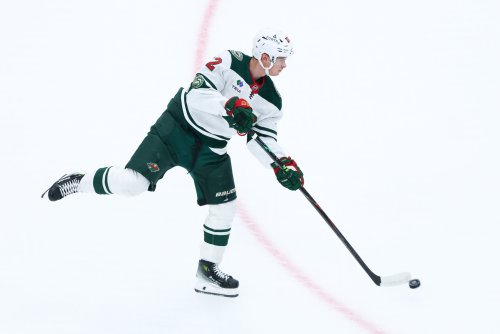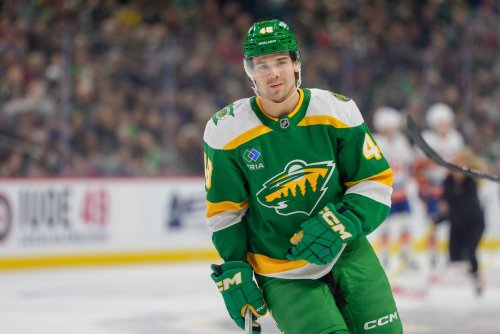
Before the Seattle Kraken gets their pick over the NHL during the expansion draft on July 21, we’ll take a look around the Minnesota Wild roster and determine how and why certain players might be heading west.
One of the most formative discussions of my young age have become those surrounding protecting expansion players. First came a period which scholars now refer to as the Vegas Rosterbation, in which every team’s fanbase and writers (and management, probably to a lesser degree) exhausted the combinations of protection lists which would best suit their teams. This is the phase of Seattle’s expansion draft in which we currently find ourselves, proving that time is a flat circle.
Next come the discussions of the expansion team’s roster, in which everybody largely concludes that they have no idea what will happen. Finally, the best part comes when people start to break down the value of side deals brokered between the expansion team and some sorry GM who built a deep roster which was victimized by the expansion draft. One example would be the analysis between the Wild saving Matt Dumba from the jaws of glittering helmet-land in exchange for speedy center Erik Haula and then-prospect Alex Tuch.
Lost in all of these stages is the discussion of goaltenders - which goalies should the expansion team select? Should teams with a young backup protect their solid starter, or shoot for the stars and keep their backup in hopes that he develops into an elite player in his prime? Even bigger-brained, should you expose your better goalie to trick the expansion team into taking them over a better skater?
These questions are often totally ignored because the truth is, none of us knows a damn thing about goaltending. It’s incredibly difficult to separate good goaltending performance from good defense, and even advanced goalie statistics are incredibly variable. Goalies also only play a little over half of an 82-game season each year, making it even harder to evaluate a player’s ability at the position before they exit their prime - making that analysis nearly meaningless as the player is no longer what they once were.
Not to mention the fact that 90 percent of fans never played the position at any meaningful level. And for those of us who did (such as my brother), it’s like amateur golfers watching a professional golfer - they’re playing the same game, but they aren’t doing the same things or operating on anywhere near the same level of understanding.
Nevertheless, we at Hockey Wilderness dare to go where no others have before, and for the first time provide a definitive and true answer to a question of goaltending analysis. Today, that question is: which goaltender should the Wild protect from selection by Seattle?
Essentially, Minnesota’s goalie protection question boils down to two sub-questions:
The second question is tough, because you have to assess Minnesota’s goaltenders based on their performance on the team for one shortened season (plus some time elsewhere in the league for Talbot, or some time in the AHL for Kahkonen). The second question is vastly more complicated because it involves roster projection into the future at the goaltending position and amongst your 18-skater dressing room. It also can’t fully be answered by this blog because discussions on where Seattle plans to source its first goalie are going to be between Seattle GM Ron Francis and his 31 colleagues around the league, not some kid who doesn’t do hockey for his day job.
Suffice it to say, however, that with Minnesota’s goalie prospect pipeline in good standing and it’s defensive prospect pool slightly thin, it’s probably best to try to lose either Talbot or Kahkonen over a player like Matt Dumba — no matter which goalie Seattle names as its price.
As for determining which goalie is better, our season grade articles on Talbot here and Kahkonen here can give a deeper dive into the players’ performance. For a quick review, see the following stats: Talbot save% .915 over Kaapo .902; Talbot GAA 2.63 over Kaapo 2.88. Talbot also led Kahkonen in the advanced statistic known as GSAx (goals saved above expectation, which adjusts the quality of scoring chances the goalies faced based on the sites’ expected goals models) on both MoneyPuck.com and evolving-hockey.com.
Evolving-Hockey’s WAR statistic also rated Kaapo as a below-replacement level goalie (minus-1.7 WAR) based on the quality of shots that he faced. By comparison, Talbot has only had two of his nine seasons post as a negative, and averages around 12.75 GAR (goals above replacement) per-season for his career. That’s on par with this year’s GAR (12.6), which was as solid of a season as we’ve seen from a Wild goaltender in the last three or four years. These stats are more predictive of future performance year-to-year than traditional stats, although they’re still pretty variable among goaltenders because goaltending is so hard to evaluate.
Talbot achieved these results based on consistently good-not-elite performance. On the other hand, consistency is typically a quality that “old school hockey” fans and managers covet in a starting goaltender. If Talbot were lost to expansion, it’s tough to imagine that Kaapo is going to steady the ship all the way next season. It’s not that Kahkonen isn’t good - he showed play of an elite level over the start of the shortened season - it’s just that his lows were so low that consistency may not come for him until later in his career. Kaapo’s rookie year was so rocky that is was literally the sub-headline of his season grade.
The reason that you would keep Kahkonen around is that you only have 29 games of NHL data on the lad. He’s young and unproven, but you’d hate to see him taken by Seattle and go onto an elite career that could come in forest green with a little patience. It’s hard not to salivate over some of his best moments and wonder if that’s his true ability. On the other hand, he’ll be going into his age 25 season next year — he won’t be getting that much better, his best-case scenario is avoiding the mistakes that caused so much trouble for him late in the season this year. Unfortunately, evaluating which goaltender is better really hangs looking at this Jekyll-and-Hyde goaltending performance and correctly determining, “which one of you is the real Kaapo Kahkonen?”
Personally, I’ve made my decision — I think that Talbot should be protected, unless you use him to keep a key skater like Matt Dumba.
It’s not so much that I can look anybody in the eye and say that I know that Talbot is a better asset than Kaapo Kahkonen. Kaapo’s age makes him incredibly appealing as an asset, and truthfully he could be flat-better than Talbot in the next one to two years. Cam Talbot also turned 34 on June 5th, and any leading statistical analyst will tell you that that number is only projected to increase.
The issue with this thinking is that looking at a younger player comes with a common fallacy: evaluators always look at young players and imagine what they could be. The correct evaluation is multi-faceted: what are you now, what could you become (good and bad), and what are the chances of each of those outcomes coming true? With Kaapo Kahkonen, what we can answer is that right now he’s totally inconsistent. Going into the future, and it’s hard to think that a 25 year old is going to eliminate every negative habit of his game. By the time we know how good he actually is with any level of certainty, Kaapo’s career will be winding down. Anybody who tells you that they know before that time is lying to you, probably for the simple reason that they’re unaware of how hard goalie analysis is.
As far as I can tell, the decision to leave Talbot exposed is high-risk: can you afford to spend the next couple of years, in which Kirill Kaprizov is deciding whether to stay here long-term, with Kaapo Kahkonen and some free agent in net (at least before help arrives from the prospect pool)? On the other hand, losing Kahkonen opens a hole at backup. That can be easily replaced, and hopefully the timing of Talbot’s future exit or mystery backup’s exit lines up with the development of a solid goalie prospect. Filip Lindberg (age 22) had a dominating .949 save% playing in the NCAA for UMass this year. Hunter Jones (age 20) is another highly-touted prospect playing now in Iowa.
Put simply: having a year of solid play from Talbot may not be something we can replace next year if Kahkonen is bad, and we may not be able to replace it for a long time. We can back-fill a young backup. Given that Minnesota is one of the best opportunities for Seattle to get a good player that can start for them, rather than just a young or utility skater, Talbot would be among their best options for top-half roster talent. For this reason, the Wild need to protect Cam Talbot over Kahkonen, giving them better leverage over Seattle.
Think you could write a story like this? Hockey Wilderness wants you to develop your voice, find an audience, and we'll pay you to do it. Just fill out this form.







Recommended Comments
There are no comments to display.
Join the conversation
You can post now and register later. If you have an account, sign in now to post with your account.
Note: Your post will require moderator approval before it will be visible.